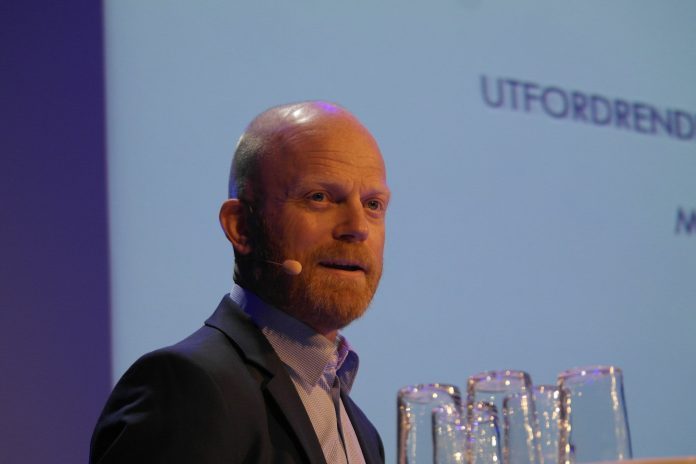Stale Hoyem buys salmon worth €2.15 million a year. And the biggest challenges he faces differ from those faced by salmon farmers.
He presents himself as the ‘stranger in our midst‘ during Nordea’s seafood seminar at the AquaNor fair in Trondheim on Wednesday afternoon. Hoyem is the general manager of Suempol Norway, purchasing arm of the major Polish distributor Suempol.
“That’s how it feels – for some. It’s not right to feel a stranger when you are working in processing,” says Hoyem. “We work with smoked salmon and have a factory in eastern Poland. We produced 40,000 tonnes last year. I bought salmon from Trondheim for roughly two billion.”
Market
Hoyem looks out over the assembly in the grand hall of Scandic Nidelven, consisting of a few hundred people associated with Norwegian fish farming, before he says: “Many of you are wondering what I think about the salmon price in the future. I think the price will remain at 5.5 euros (£ 51) per kilo in the second half of the year.”
 “Nobody talks about the market,” Hoyem continues, and does not hide that this is his favorite subject.
“Nobody talks about the market,” Hoyem continues, and does not hide that this is his favorite subject.
“Ask the industry about its challenges, and everyone will mention costs. Lice, diseases and production restrictions. For us who are in the market, it is a little different.”
Contrast
“Our customers, the German supermarkets, are concerned about sustainability, traceability, price, food security and innovation. Our challenges are far apart.”
Hoyem then points his index finger at the fish farmers in the exhibition hall.
“We have never had such major product quality challenges as at this moment, nor have we ever had such high salmon prices. There is certainly a connection there, and it is particularly important for lice treatment as a central cause. We have never seen so much melanin staining and pale color either. Color and texture are the alpha and omega for those of us who are involved in processing. To pay 70, 80 and 90 kroner for this (€7.50 – €9.50) – it’s our daily routine.”
Challenging year
“At the same time smokers, such as Suempol, are squeezed between suppliers and customers, as they have long-term agreements with the supermarket chains, but not enough contractual opportunities with the fish farmers.”
“Being unable to get contracts is unusual. 2016 became a pretty challenging year for us, for that reason.”
“People will ask, ‘Can’t you enter into financial contracts then?’ But how can a commodity exchange that converts 90,000 tons a year set the price when Norway’s salmon production is 1.2 million tons? Only one percent of the salmon turnover goes through the system there. They have 50-week contracts, while I like to do it five times,” he said, highlighting a tight liquidity bottleneck.
At the same time salmon sales decrease as a result of high salmon prices in several key markets.
“In Germany, our main market, the sale of salmon products has fallen by 11 per cent. Smoked salmon has fallen by 12 per cent. In Poland, our home market, sales are down 32 percent,” says Hoyem.


